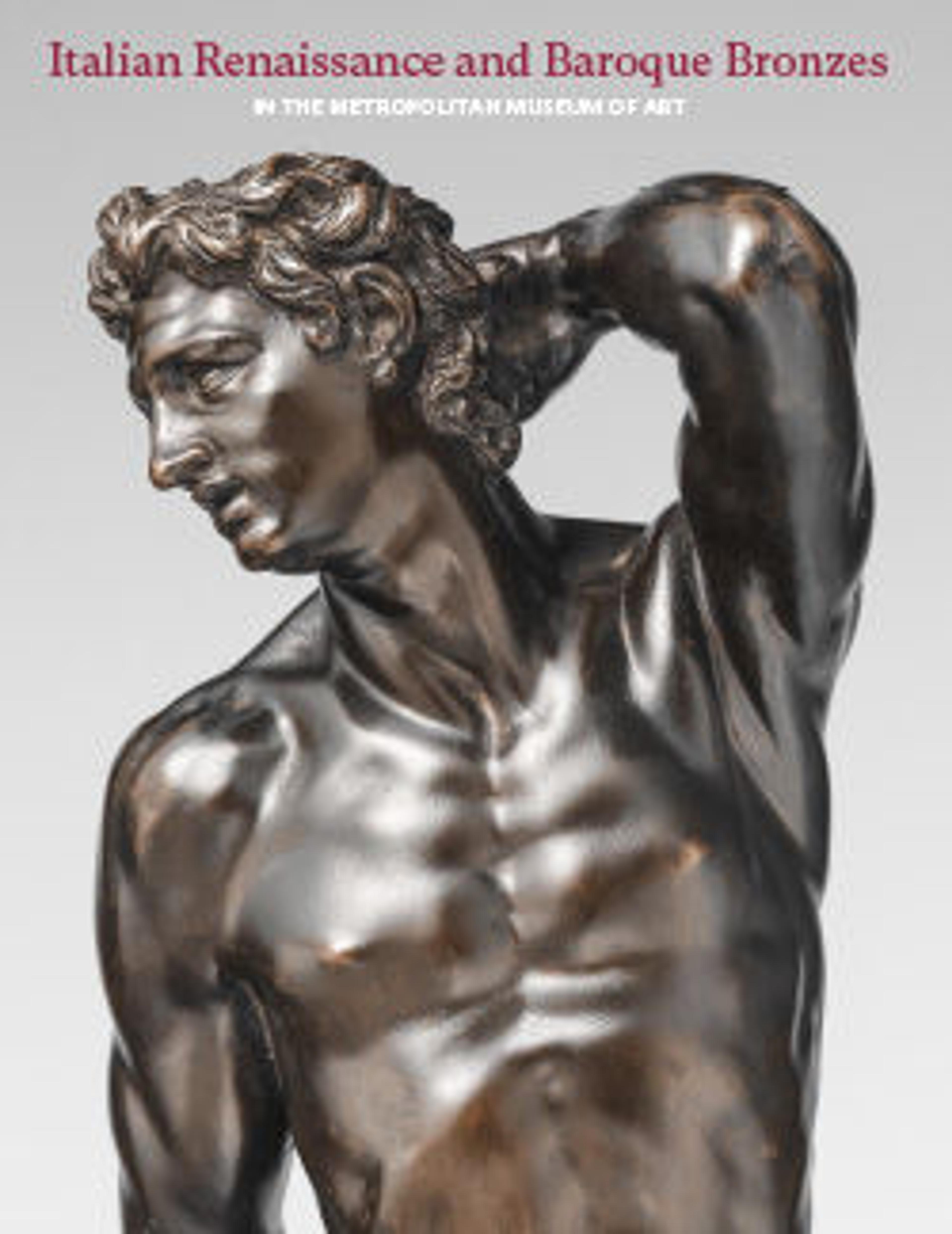Bathing Venus
The nude figure stands in a “hipshot” pose, her left foot resting on a high molded pilaster. This and our other Bathing Venus (cat. 124) came to The Met in 1924 with the Mills bequest. At the time, curator Joseph Breck called the latter “a superb example” of Giambologna’s style; the present bronze was characterized less favorably as “a school variant of the same subject.” Both derive from Giambologna’s design for a bathing Venus that was translated as a large marble statue, the Cesarini Venus, in 1583 (U.S. Embassy, Rome), and in numerous bronze reductions, the first of which is thought to be the signed statuette that was sent to Emperor Maximilian II in 1564–65 and is now in Vienna (p. 00, fig. 124a). The composition enjoyed extraordinary success long after Giambologna’s death in 1608.
The present cast has received little scholarly attention. With its thin square base, it differs from a stream of round-based derivations that Manfred Leithe-Jasper has linked to the Cesarini marble, which was adapted to a circular pedestal when it was restored in 1616.[1] He has tied square-based versions, such as a statuette in the Stift Klosterneuburg (fig. 125a), to Giambologna’s autograph bronze in Vienna. The square base along with certain stylistic features may point to a Northern origin for our Bathing Venus. Close in style and size to the Klosterneuburg cast, it invites a similar reading. Though faithful to Giambologna’s original conception, certain details have been altered or misinterpreted, such as the twists in the hair, the draping of fabric around the legs, and the rumpled, disjointed cloth tightly held over the left breast. Such revisions classify these works as distant meditations on the master’s primo pensiero. Leithe-Jasper assigned the Klosterneuburg statuette to a South German sculptor and underlined its formal weaknesses in the treatment of the hair and drapery.[2] Compared to that of our bronze, however, the rendering of the hair on the Klosterneuburg cast is more sophisticated, suggesting that it represents an intermediate phase in the replication sequence that separates The Met’s Bathing Venus from Giambologna’s original model in Vienna.
-TM
Footnotes
(For key to shortened references see bibliography in Allen, Italian Renaissance and Baroque Bronzes in The Metropolitan Museum of Art. NY: The Metropolitan Museum of Art, 2022.)
1. Leithe-Jasper and Wengraf 2004, pp. 146–47, cat. 12; Leithe-Jasper 2006b.
2. C. Avery et al. 1978, p. 86, cat. 4a.
The present cast has received little scholarly attention. With its thin square base, it differs from a stream of round-based derivations that Manfred Leithe-Jasper has linked to the Cesarini marble, which was adapted to a circular pedestal when it was restored in 1616.[1] He has tied square-based versions, such as a statuette in the Stift Klosterneuburg (fig. 125a), to Giambologna’s autograph bronze in Vienna. The square base along with certain stylistic features may point to a Northern origin for our Bathing Venus. Close in style and size to the Klosterneuburg cast, it invites a similar reading. Though faithful to Giambologna’s original conception, certain details have been altered or misinterpreted, such as the twists in the hair, the draping of fabric around the legs, and the rumpled, disjointed cloth tightly held over the left breast. Such revisions classify these works as distant meditations on the master’s primo pensiero. Leithe-Jasper assigned the Klosterneuburg statuette to a South German sculptor and underlined its formal weaknesses in the treatment of the hair and drapery.[2] Compared to that of our bronze, however, the rendering of the hair on the Klosterneuburg cast is more sophisticated, suggesting that it represents an intermediate phase in the replication sequence that separates The Met’s Bathing Venus from Giambologna’s original model in Vienna.
-TM
Footnotes
(For key to shortened references see bibliography in Allen, Italian Renaissance and Baroque Bronzes in The Metropolitan Museum of Art. NY: The Metropolitan Museum of Art, 2022.)
1. Leithe-Jasper and Wengraf 2004, pp. 146–47, cat. 12; Leithe-Jasper 2006b.
2. C. Avery et al. 1978, p. 86, cat. 4a.
Artwork Details
- Title:Bathing Venus
- Artist:Imitator of Giambologna (Netherlandish, Douai 1529–1608 Florence)
- Date:17th–18th century
- Culture:Possibly Germany
- Medium:Bronze
- Dimensions:Overall (confirmed): 13 × 3 5/8 × 4 in. (33 × 9.2 × 10.2 cm)
- Classification:Sculpture-Bronze
- Credit Line:Gift of Ogden Mills, 1924
- Object Number:24.212.17
- Curatorial Department: European Sculpture and Decorative Arts
More Artwork
Research Resources
The Met provides unparalleled resources for research and welcomes an international community of students and scholars. The Met's Open Access API is where creators and researchers can connect to the The Met collection. Open Access data and public domain images are available for unrestricted commercial and noncommercial use without permission or fee.
To request images under copyright and other restrictions, please use this Image Request form.
Feedback
We continue to research and examine historical and cultural context for objects in The Met collection. If you have comments or questions about this object record, please contact us using the form below. The Museum looks forward to receiving your comments.
